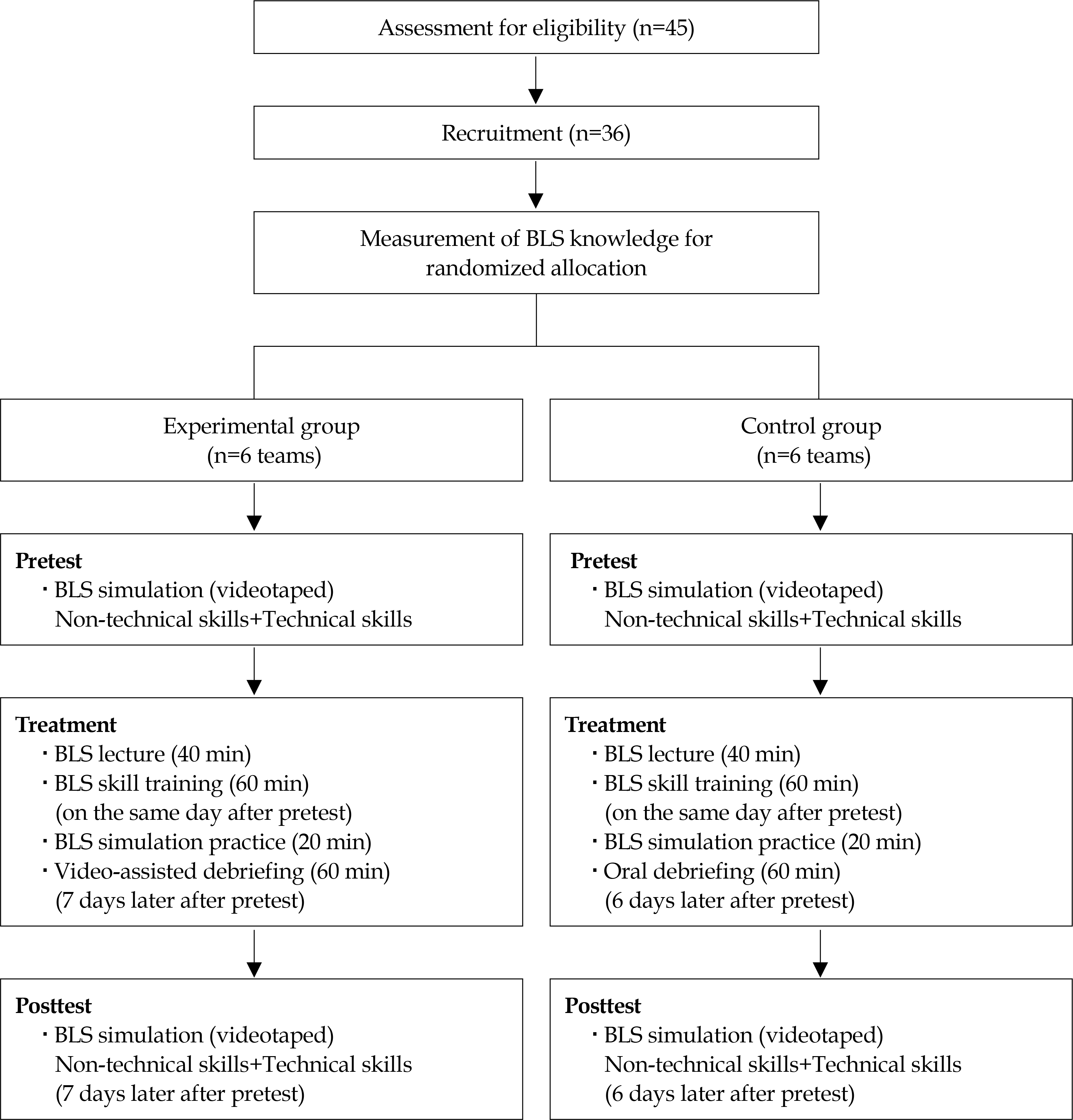Abstract
Purpose
The purpose of this study was to investigate the effects of simulation-based training (SBT) for basic life support (BLS) utilizing video-assisted debriefing (VAD) about non-technical skills (NTSs) and technical skills (TSs). The goal of the proposed study is the evaluation of a teaching method about the correct application of cardiopulmonary resuscitation (CPR).
Methods
The study design was a control group pre-and post-test non-synchronized experimental design. The sample included twelve teams of 36 nursing students. Both the experimental and the control groups received the SBT for BLS. Only the experimental groups received VAD where as the control groups had a verbal debriefing. Raters who used checklists for TSs and NTSs evaluated both groups. Data were analyzed by the SPSS 20.0 using Cronbach's ⍺, Intraclass Correlation Coefficient (ICC), Mann-Whitney U test and Willcoxon signed rank test.
Go to : 
REFERENCES
1.Holmberg M., Holmberg S., Herlitz J. Effect of bystander cardiopulmonary resuscitation in out of hospital cardiac arrest patients in Sweden. Resuscitation. 2000. 47:59–70. http://dx.doi.org/10.1016/S0300-9572(00)00199-4.
2.Kim DH., Lee YJ., Hwang MS., Park JH., Kim HS., Cha HG. Effects of a simulation-based integrated clinical practice program (SICPP) on the problem solving process, Clinical competence and critical thinking in a nursing student. Journal of Korean Academic Society of Nursing Education. 2012. 18(3):499–509.
3.Field JM., Hazinski MF., Sayre MR., Chameides M., Schexnayder MR., Hemphill R, et al. Part 1: executive summary of 2010 AHA guidelines for CPR and ECC. Circulation. 2010. 122(3):S640–56.
4.Korea Association of Cardiopulmonary Resuscitation. Common cardiopulmonary resuscitation guideline development and distribution [Internet]. Seoul: Korea Association of Cardiopulmonary Resuscitation;2011. [cited 2015 January 1]. Available from:. http://www.kacpr.org/popup/file/2011_guidelines.pdf.
5.Flowerdew L., Brown R., Vincent C., Woloshynowych M. Development and validation of a tool to assess emergency physicians'non-technical skills. Annals of Emergency Medicine. 2012. 59(5):376–85. .e4.
6.Agency for Healthcare Research Quality. Strategies and tools to enhance performance and patient safety [Internet]. U.S.: Department of Health and Human Services;2009. [cited 2015 January 1]. Available from:. http://teamstepps.ahrq.gov/index.htm. accessed April 2011).
7.Cooper S., Cant R., Porter J., Missen K., Sparkes L., McConnell-Henry T, et al. Managing patient deterioration: assessing teamwork and individual performance. Emergency Medical Journal. 2013. 30(5):377–81. http://dx.doi.org/10.1136/emermed-2012-201312.

8.Walkera S., Brettb S., McKayc A., Lambdend S., Vincente C., Sev-dalise N. Observational Skill-based Clinical Assessment tool for Resuscitation (OSCAR): development and validation. Resuscitation. 2011. 82:835–44. http://dx.doi.org/10.1016/j.resuscitation.2011.03.009.

9.Andersen PO., Jensen MK., Lippert A., Østergaard D., Klausenb TW. Development of a formative assessment tool for measurement of performance in multi-professional resuscitation teams. Resuscitation. 2010. 81:703–11. http://dx.doi.org/10.1016/j.resuscitation.2010.01.034.

10.Judy JR. Catherine B. Facilitated debriefing. Wendy MN, Fe-lissa RL, editors. High-fidelity patient simulation in nursing education. Sudbury MA: Jones and Bartlett;2008. p. 369–85.
11.Scherer LA., Chang MC., Meredith JW., Battistella FD. Videotape review leads to rapid and sustained learning. American Journal of Surgery. 2003. 185(6):516–20. http://dx.doi.org/10.1016/S0002-9610(03)00062-X.

12.Boet S., Bould D., Bruppacher HR., Desjardins F., Chandra DB., Naik VN. Looking in the mirror: self-debriefing versus instructor debriefing for simulated crisis. Critical Care Medicine. 2011. 39(6):1377–81. http://dx.doi.org/10.1097/CCM.0b013e31820eb8be.
13.Sanborn DE., Pyke HF., Sanborn CJ. Videotape playback and psychotherapy: a review. Psychotherapy: Theory, Research & Practice. 1975. 12(2):179–86. http://dx.doi.org/10.1037/h0086424.

14.Rogers A. Videotape feedback in group psychotherapy. Psychotherapy; Theory, Research, and Practice. 1985. 5:37–9. http://dx.doi.org/10.1037/h0088647.

15.Newby T., Stepich D., Lehman J., Russell J. Instructional technology for teaching and learning. USA: Prentice-Hall Inc;2000.
16.Park IH. The effects of video-aided feedback in pre and post operative nursing simulation practice. [master's thesis]. Asan: Soonchunhyang University;2013.
17.Kim JY. Development of a scenario of simulation and analysis of the effect of debriefing. [master's thesis]. Sungnam: Eulji University;2012.
18.Grant J., Moss J., Epps C., Watts P. Using video-facilitated feedback to improve student performance following high-fidelity simulation. Clinical Simulation in Nursing. 2010. 6(5):e177–84. http://dx.doi.org/10.1016/j.ecns.2009.09.001.

19.Roh YS., Kelly M., Ha EH. Comparison of instructor-led versus peer-led debriefing in nursing students. Nursing and Health Sciences. 2016. 18(2):238–45. http://dx.doi.org/10.1111/nhs.12259.

20.Nadler I., Sanderson P., Van Dyken C., Davis P., Liley H. Presenting video recordings of newborn resuscitation in debriefing for teamwork training. BMJ Quality & Safety. 2010. 20(2):1639. http://dx.doi.org/10.1136/bmjqs.2010.043547.
21.Cooper S., Bogossian FE. Managing patient deterioration: enhancing nurses' competence through face-to-face and web based simulation techniques. 3rd ed.Melbourne: Victoria;2013. http://dx.doi.org/10.1136/emermed-2012-201312.
22.Luctkar-Flude M., Baker C., Pulling C., Mcgraw R., Dagnone D., Medves J, et al. Evaluating an undergraduate interprofessional simulation based educational module: communication, teamwork, and confidence performing cardiac resuscitation skills. Advances in Medical Education and Practice. 2010. 1:59–66. http://dx.doi.org/10.2147/AMEP.S14100.
23.Pucher PH., Aggarwal R., Singh P., Srisatkunam T., Twaij A., Darzi A. Ward simulation to improve surgical ward round performance. Annals of Surgery. 2014. 260(2):236–43. http://dx.doi.org/10.1097/SLA.0000000000000557.

24.Jung JS., Hur HK. Effectiveness and retention of repeated simulation-based basic life support training for nursing students. Journal of Korean Critical Care Nursing. 2013. 6(2):24–36.
25.Richard HR. Manual of simulation in healthcare. Korean Society for Simulation in Healthcare, translator. Seoul: Yedang;2010.
26.Dufrene C., Young A. Successful debriefing-best methods to achieve positive learning outcomes: a literature review. Nurse Education Today. 2014. 34(3):372–6. http://dx.doi.org/10.1016/j.nedt.2013.06.026.
27.Bowden T., Rowlands A., Buckwell M., Abbott S. Web-based video and feedback in the teaching of cardiopulmonary resuscitation. Nurse Education Today. 2011. 32(4):443–7. http://dx.doi.org/10.1016/j.nedt.2011.04.003.

28.Kardong-Edgren SE., Starkweather AR., Ward LD. The integration of simulation into a clinical foundations of nursing course: student and faculty perspectives. International Journal of Nursing Education Scholarship. 2008. 5(1):1–16. http://dx.doi.org/10.2202/1548-923X.1603.

29.Kim JR. English teaching and learning model development using interactive white boards. Korean Journal of Teacher Education. 2009. 25(1):109–41.
Go to : 
Table 1.
Homogeneity Test of Dependent Variables
Table 2.
Effects of Basic Life Support Simulation Training Using Video-assisted Debriefing on Non-technical Skills (N=12)
Table 3.
Effects of Basic Life Support Simulation Training Using Video-assisted Debriefing on Technical Skills (N=12)




 PDF
PDF ePub
ePub Citation
Citation Print
Print



 XML Download
XML Download